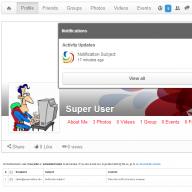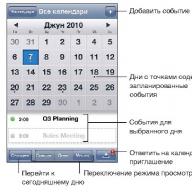Hi all! In this article you will learn how to view your website history on different browsers. If you often use the Internet, then you probably open a lot of links, sites and applications. This is all saved in the browser history. Below I will show you how you can read your browsing history on some browsers.
1. Google Chrome
- Find the wrench icon under the browser close button (it is located just below the “Zoom” line), click on it and open “History”. History will show you the name of the site, the exact date and time you visited it.
- You can also find the site page you are looking for using the History Search.
- By clicking on the “History” line, you will see links to sites that you visited recently. If you want to see the names of sites from last week or month ago, click on the " Previously" button.
- You can also open the history using the keyboard shortcut: Ctrl+H (English).
2.Opera
- If the sidebar is missing. In the upper left corner of the screen, click on the button and select “History” in the menu that appears.
- If the sidebar is enabled. Find the clock icon and click on it. The "History" window will open. Visited sites are sorted there as follows: today, yesterday, this week, this month, earlier. To open any of the periods, just click on it once with the left mouse button.
If you are looking for a specific site, then it will be more convenient to use a search engine (line with a magnifying glass).
How to view your website visiting history?
Here's how to view your website history using the keyboard:
Ctrl + Shift + H (English).
3. Mozilla Firefox
- Find it in the upper left corner orange button and click on it. In the window that opens on the right, hover your mouse over the line “Journal”. And then click “ Show entire log».
- If you don't have the orange button, then use the menu bar at the top of the browser window. There, find “Journal” and open it. A search bar will be available in the upper right corner. So, you can find a specific site.
You can also call up the browsing history log using the keyboard:
Ctrl+Shift+H (English).
4. Safari
- In the main menu, select: “History” – “ Show full history».
- On the keyboard you can do this like this: Alt + Command + 2.
This is where I will conclude the article. I would like to invite you to subscribe to new blog articles, you can do this by simply entering your email at the end of the article and I will send you something new directly to your email.
Reading time: 6 minutes. Views 343 Published 02/04/2019
The computer has taken a strong position in everyone's life, but some users, who regularly access this tool, have not yet explored all its capabilities. We decided to partially correct this situation and talk about.
Here, as a rule, the truth lies in the details. Having asked a similar question, some want to see the history of surfing the Internet, others want to evaluate the contents of the application and security system log. Therefore, in this article we will answer both questions, and at the same time we will talk about how you can limit access to your personal PC.
Browser history: how to view it
Most often, a computer is used to surf the Internet. Therefore, first of all, let's figure it out.
The algorithm of actions depends on which browser is the main browser on the device.
- The most common browser today is Google Chrome. Moreover, the Yandex browser is based on it, which means the instructions for them will be the same. Just open the menu, the button of which consists of three vertical dots and is located in the upper right part of the screen. In the list we find the “history” section. Another list will open, which will show the last closed browser tabs, as well as the ability to open the entire history.
- If the main one is IE, this is extremely rare lately. This is due to the fact that competitors' products have better characteristics and performance. Nevertheless, we cannot ignore the standard Windows OS browser. To see its history, you need to find the star icon in the upper right corner and go to the “Journal” tab. It is worth noting that it is more sophisticated, if only because it provides the ability to navigate through records by changing the viewing date.

- For Opera browser users, the instructions will be as follows. You need to look for your browsing history in the left block; if there is none, then just click on the program logo. The history is represented by a clock icon; in the second case, look for it in the drop-down menu list.

- Firefox users can use the keyboard shortcut CTRL+SHIFT+H or look for the house icon in the upper right corner and open the menu. In it, select “Journal”, it is indicated by a clock icon.

- Fans of Apple brand technology who use the standard Safari browser should find the “History” tab at the top of the window and select the “Show entire history” command (History – Show History).
We figured it outhow to view history on computerfor various browsers. But there are situations when sophisticated users clean up all traces of themselves. Is it possible to recover data after deletion? If special software was not used to completely delete data, then yes, this is possible. However, you should understand that the entire history will be restored only if synchronization with cloud storage is established; otherwise, you will only be able to see sites that use cookies.
How to view history on a computer: Application and security log
This section will be of interest to those who did not find anything interesting in the browser and would like to know what actions were performed on their PC in general. What files were opened, programs used and much more. Experienced users know that the operation of the computer is completely recorded and every action taken is recorded. It is enough to know how and which journal to contact in order to find out the information of interest.
Application usage history
What can you learn in this magazine? Firstly, the exact time of launch of any application, be it a game, instant messenger, office application or other program. Secondly, the PC owner finds out the duration of use of a particular software.
Not all users know where to find this magazine. It's actually quite simple.

A list of all applications that are currently running or have been used previously will open. By clicking on the desired item, you can see detailed information at the bottom of the window.
Security log
Another interesting section that will be of interest to computer owners. It contains information about logging in or out of the system, that is, data when the computer was turned on and off.
You can evaluate the available statistics and compare them with periods of your activity. In this case, the owner will have irrefutable proof that his car was used by strangers.
The section is in the same location as the previous journal. Just go down one position in the left block of the dialog box. 
Recently modified files
Another option for controlling unauthorized activity on your PC. Here we will tell you how to see created, edited and even viewed files.
The algorithm is extremely simple and will not cause difficulties, even for inexperienced users.

The user will see a list of recently created or modified files.
These are the available options,how to view history on computerexhausted. They are quite enough to see whether the PC was used by an unauthorized user, as well as to fully assess the scale of the activity.
How to restrict access to your PC
If the owner does not like the fact that his computer is being used by strangers, . To do this, open the “Accounts” section in the device settings and make changes to the login parameters. Click the "Add" command and enter the desired password.
If the owner wants more sophisticated methods, then you can create a kind of trap using the “Task Scheduler”.

Choose the necessary action, and you will be able to catch the offender after the fact.
Perhaps this is all we would like to tell you in answer to the question,how to view history on computer. Thanks to the article, you can not only see what you searched for and viewed in the browser, but also track at what time you logged in and out of the system. It will become known which files and programs were launched by a third-party user. In addition, our readers know that even deleted browser history can be restored if necessary. Share the article on social networks if you found it useful. Come to the discussion, let's discuss who and how often uses your computer without permission. And stay with us, we have a lot of useful things.
To monitor computer activity and trace the causes of errors, Windows keeps a record of recent events and actions in the system. Using this feature, you can see what applications were recently installed on the system, when the last login sessions were made, and what actions were performed.
You can view your latest activity on your computer using your browser history and the date some files were last opened. You can also view recent documents in the corresponding section of the Start menu.
Quick navigation through the article
Windows log
To view the latest events on your computer using Windows Journal, you must:
- Open the Start menu.
- Enter “View event logs” into the search bar.
- Select the application of the same name in the search results.
- Wait for the window to load and the list of events to be built.
- Open the Windows Logs tab.
- Open the desired journal by double clicking and view the events.
Recent Documents
You can view recently opened files in the “Recent Documents” system menu. By default, this section is disabled in Windows 7, but the user has the opportunity to activate it. To do this you need:
- Right-click on the Start button.
- Select the “Properties” item in the context menu.
- Go to the Start Menu tab.
- Click the “Configure” button.
- Find the line “Recent documents” in the list and tick it.
- Save the changes by clicking the "OK" button.
Browser history
To view the history of open pages in the browser you need to:
- Launch a web browser.
- Press the key combination “Ctrl” + “H”.
- Select, if necessary, the period of the displayed history.
- View open sites and the date the page was visited.
Date the file was opened
Using standard Windows operating system tools, you can view the date the file was last opened. To do this you should:
- Right-click on the file.
- Select “Properties” from the menu that appears.
- On the “General” tab, look at the date the file was opened.
- Go to the “Details” tab and see the date the file was saved or modified.
Almost all PC users sooner or later become interested in how to find history on a computer. After all, by looking through it, you can see what applications were open, what resources the user visited, and even at what time the computer was turned on and off. There are special programs that allow you to view the history of visits. But to work with such utilities, you need to have a good understanding of PC settings. After all, using them can damage data that you will not be able to recover.
How to find your browsing history on your computer
If you have a desire to see which sites you visited on your PC, but you don’t know where the Internet browsing log is located on your computer, you shouldn’t be sad about it. There is nothing difficult about this operation.
For the Opera browser, you need to move your mouse pointer to the upper left corner of the screen, select the “History” section from the list of items provided, after which the chronology of visits for the last month will open on your screen. You can also open “History” using the Ctrl and H key combination. If you want to delete history from your computer, click on the corresponding button located at the top right.
For the Mozilla browser, open the “Journal” tab, which is located in the upper left corner of the screen. There you can view the entire chronology, as well as delete it. You can also open the “Journal” using the key combination Ctrl+Shift+H; when deleting, add the Del key to this combination.
For Internet Explorer, open the top menu and go to the “View” section, then go to the “Explorer Panels” item, there you will see the “Journal” sub-item, which can be opened with the same key combination as in Opera.
If you are interested in the history of the QIP ICQ client, go to the C:\Program Files\QIP\Users\ folder on your computer. From the list, select the required ICQ number, go into it, find the History folder and, using any text editor, view the contents of the text files.

To view all applications running on your PC, open the folder located at c:\WINDOWS\Prefetch\. In order to find out the password entered to open programs, download and install the Punto Switcher utility. This application automatically switches from English to Russian, it has a diary function that allows you to save passwords for all programs that open.
You also have the opportunity to download and install special utilities, which are also called keyloggers. Thanks to these programs, all actions that occur on the keyboard will be under your control. The application records everything that happens and can, if necessary, record sound and pictures during communication in programs such as Skype.
To protect yourself and your PC from this kind of utilities, you need to use anti-spyware software or a modern antivirus that has the latest databases.
As you can see, viewing the chronology of visits on a personal computer or laptop is not difficult at all. If you want to hide the sites you visited from your browser, do not forget to clear your history. Also, deleting history automatically deletes passwords from email or social networks that were saved by your browser, which will prevent other users from logging into them and viewing your messages.

Sooner or later, almost all Internet users are interested in the history of actions on a computer or laptop. You can find out what programs were opened on the computer, what sites were visited, when the computer turned on and off, etc. With the help of special software, you can do all this, but be careful: if you do not understand the computer settings well, then you can damage the data on it that cannot be recovered. Moreover, if the user independently deletes all data after working at the computer, then it will be almost impossible to recover this information.
For these purposes, there are special programs called keyloggers (from the English keylogger). Using this program, you can monitor all keystrokes, mouse movements, record the time you press keys, and even take screenshots at certain intervals. The program maintains a special log file in which everything is recorded and can even intercept sound from the microphone and image from the webcam. To protect against keyloggers, you need to use anti-spyware software or a modern antivirus program with up-to-date databases.
To view history in browsers, you just need to select a specific menu item. In Opera, you need to click on the “Opera” button in the upper left corner and select the “History” menu item (or press the key combination Ctrl+Shift+H). In Mozilla Firefox, you need to select “Log” -> “Show entire log” in the top menu or use the same key combination. In Google Chrome, you need to click on the button with three stripes in the upper right corner and select “History”, or use the key combination Ctrl + H. In Internet Explorer, in the top menu, select “View” -> “Explorer Panels” -> “Journal” (key combination Ctrl+Shift+H).
To view the history in the QIP ICQ client, you need to go to the c:\Program Files\QIP\Users\ folder and select the ICQ number you need, then inside this folder go to History and use any text editor to view the contents of the text files Number. txt (where “Number” is the ICQ UIN of your interlocutor).
If you want to see a list of all programs that were launched on your computer, then you need to go to the c:\WINDOWS\Prefetch\ folder. To view all the characters typed on the keyboard, you will need the Punto Switcher program (initially it automatically switches the layout from English to Russian), but it has a diary function that allows you to record all the characters typed in all programs.
To delete history from all browsers, use this video:
How to view the history of actions on your computer
In the age of dominance of information technology, not all users know how to view history on a computer. This function, as a rule, is not in demand among ordinary users until any problems arise with loading the operating system, restoring the sequence of the operating procedure, or illegal use of the computer by a third party.
Computer and application event log
The developers of the Windows operating system have provided users with a special function with which they can monitor all processes running on the computer and any changes in the system. For example, when the computer turned on, what updates were installed, what crashes or system errors occurred, etc.
All actions and information can be tracked in special logs, where an ordered list of events is compiled. The logs are located in the Administration section, which can be accessed through the control panel. From a number of shortcuts that appear, you must select View events, which contains the information you are looking for. A window opens, divided into 3 parts: a category tree, a list of events and actions. For the latter, there is the possibility of saving and searching.
Next, you can select Windows logs or application logs where you can view the event history. When you right-click on a specific log, a number of suggested actions are highlighted, including clearing the log. This command allows you to both delete history on your computer and increase memory, as well as hide traces of user intervention in running processes.
History of visited web pages
Information about your movements on the Internet can be found in any web browser. There is such a tool as browser history, which displays all visited web pages, the time and date of their viewing. You will need to launch the browser, go to the Settings or Tools menu (depending on the browser type), and open the History tab. Or, after opening the browser, use the hotkey combination Ctrl+H (they are the same in all types of browsers). As a rule, there is a search bar, for example, if the user has forgotten which site he found interesting material on.
Each browser has its own browsing history and can be called a Log. You can view the detailed history only if you have not used the “incognito” (private browsing) mode, since in the interests of protecting personal data, information about site visits is not saved or displayed.
If it is necessary to protect private information from third parties, the user thinks about how to clear the browser history. This is done simply. You will need to go into your browsing history, select the “Clear” command and decide on the period for which you want to perform the specified action.




